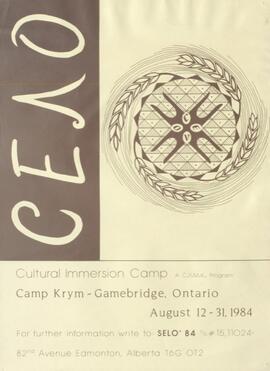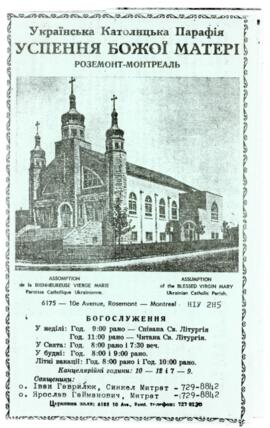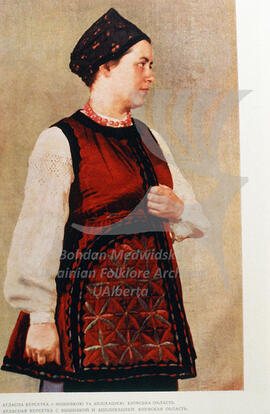Advertisement for a cultural immersion camp at Camp Krym-Gamebridge, Ontario.
Describes the history and purpose of The Cultural Immersion Camp, (C.I.C.), also known as "Selo" held in various locations of Saskatchewan and Manitoba
Pozdal, Ann6th annual Edmonton at Northgate Lions Senior Citizens Recreation Centre; a horticultural event 46.
at Humanities Centre, U of A, Edmonton A Conference exploring Ethnicity and Feminism in Commemoration of the 100th Anniversary of the Ukrainian Women's Movement.
This item contains recordings from the Second Banff Conference on Central and East European Studies.
Presentation by Mr. Petr Czarnowsky: Eastern Europeans, despite their proportion of the population, came to form a large number, often over 50% of ethnic associations in Alberta. This includes ethnic organizations, arts organizations, and linguistic schools. Policies of multiculturalism have helped to form these figures, but have had the unforeseen consequence of adding to confusion about Eastern European ethnic groups on the part of students and teachers alike.
Presentation by Mr. Joanna Mateko on the problems already being faced in the study of Poles. She came from Poland associated with the Polish Academy of Sciences in Warsaw for 15 years. She did work in the field of Polish history, having published numerous articles and co-author of bibliographies that were compiled by the Polish academy of sciences. She does her research on the Poles in Alberta. A problem that exists in the study of Poles is the inaccuracy of academic and official documents pertaining to Polish settlement in Canada, and the difficulty in unearthing accurate depictions and statistics of Polish settlers, and Slavic settlers more generally. This can be derived from a lack of knowledge from Canadian officials, and a lack of consciousness amongst many Slavic groups, particularly the Poles and Ukrainians.
Presentation by Mr. John Sokolowski, a graduate student in the department of Slavic Languages, his first graduate program was as a Classicist. He does work on the Russians and Belarussians. He started his work on the East Slavs, the Russians, Belarussians, and Ukrainians in Alberta. They no longer work on the Ukrainians as so much work has been published. They started their study with the Russians and Belarussians, they hope to determine an accurate number of people of Russian and Belarussian origin in Alberta. Contention on the accurate number of Russians and Belarussians in Canada, as the definition of Russian has changed over time, with many early documents associating many non-Russian ethnic groups as Russian. Dynamics have changed with census records over the years, which still continue to be unreliable. There is thought to be far more Belarussians in Canada than official census documents would suggest.
Presentation by Mrs. Dr. Yermilla Horna University of Calgary Department of Sociology. Dr. Horna was educated in Prague and Bratislava came to Canada in ’58, taking part in the project doing the history of the Czechs and the Slovaks. She got a grant for the study of patterns of adjustment of Czechoslovaks, the so called refugees of 1968-1969. The study focused on pre-1968 settlement of Czechoslovaks in Canada to figure out if incoming refugees had a previous basis to go off of, or had to ‘start from scratch’. Research found majority of Czechoslovaks came to Alberta as miners, farmers, or other labourers, mostly from Slovakia. Greatest wave of Czechoslovak migration prior to 1968 came in 1885.
Presentation by Mr. Kostash: Talks about the function of universities. Talks about how East European and Soviet Studies at the university follows the same functions. Mentions that one who takes particular focus on the East European courses offered by the University can find themselves being skilled and knowledgeable scholars. Initiatives by professors at the university to make sure students in the field go out to the ethnic communities to get a feel for how they are. Talks about the importance of community approval and funding for new programs. Stresses transparency of activities in programs as it relates to the community.
Presentation by Mr. Duruviches, a member of the Lithuanian community, and President of the Baltic Society: Discusses the contention with the label ‘Soviet’, coming from Lithuania, and the history Lithuania has with the Soviet Union. The importance of having a place such as a University to study one’s heritage. Expects from the University that it is kept in mind that although their issues are similar at the moment, that Baltic peoples are not Slavic peoples.
Presentation by Dr. Bergin from the Faculty of Education: has a strong interest in Mennonite culture. Difficulties because of mixed loyalties on representing different groups; particularly the Mennonites, who aren’t easily identified by typical visages.
Presentation by Dr. Sukoversky: the definition of a collection, and that professors start collections. Students can start collections too. Ethnic groups can start collections.
Presentation by the Chairman of Edmonton Historical Board
Presentation by Mr. Kistner: Wasn’t prepared to present but is talking from the perspective of a foot soldier. He is Baltic German born in Tallinn Estonia. Talks about how maps often forget about the islands of Estonia. Baltic Germans is a very small group. It’s worthwhile for even very small groups to write their history and preserve their heritage. In doing work there’s lots of assistance needed, time, and footwork. Being a small group has its advantages, no need for sampling.
Typical school bus, a child
Part 1: Born on February 14, 1895 in the village of Vil’kivtsi (??) of Borshchiv povit, Halychyna; his mother Varvara Hrubiy (??), his father was a tkach, was in Austrian army; Semen had 3 brothers and 1 half-sister; his father organized Tovarystvo tverezosti in his village and Tovarystvo dopomohy (?); mother decided to go to Canada because the family did not have enough land for 4 sons; the family left for Canada in 1899; came to Ukraine to visit in 1922 - “Mesionar” published warnings about him; came in 1899 to Winnipeg, then to a small colony “Franklin”, they bought a farm; Hans Valley had a school which Sawchuk went to, the teacher was Polish; first Ukrainian priest in their area was Fr. Dmytriv; Metropolitan Maxim (?); family moved to Saskatchewan in 1908 (a farm 40 miles from Yorkton); French priests served for Ukrainians trying to get rid of the Greek-Catholic Church; Sawchuk learned how to read Ukrainian himself; penname “Semen Matej”(??); Ukrains’kyi holos was started by the Ukrainian teachers (Fr. Vasyl’ Kudryk, Firney (??)); Bishop Budka and Kanadiis’kyi rusyn (later it became Kanadiis’kyi ukrainets’); 1908 - Sheptyckyi’s visit to Canada; “Taini pravyla” of the Catholic priests.
Part 2: Ukrains’kyi holos vs. Ukrains’kyi rusyn; 1916 - 1st Ukrainian Narodnyi Congress in Saskatoon; Bishop Budka; was studying at that time at the bursa (Mohyla Institute); Tovarystvo “Bursuk”; Sawchuk joined the Tovarystvo “Kameniari”; Sawchuk was the 1st Secretary of the Narodnyi Dim in Saskatoon; Julian Stechyshyn; Svystun, money scandal; Dr. Kushnir from BUC and his relations to Svystun; Fr. Mayevs’kyi (??); Archbishop Teodorovych; Metropolitan Lypkivs’kyi.
Part 3: Rada Ukrains’kykh Tserkov; CUC; Kosar on Ukrainian-Canadian Legions; Dr. Datskiv on CUC as Ukrainian government in exile; Tracy Phillips, Simpson and creation of CUC; Svystun; Fr. Kushnir about Svystun as a Catholic; Kosar as a person; SUS; Sawchuk in Ottawa in 1939; Sawchuk got a Lieutenant rank in 1921, during WWII became a Chaplain in 1942, Fr. Symchych as a Chaplain, Fr. Kovalyshyn; Fr. Horoshko; Helen Kozycky; Danylo Skoropads’kyi; coming back to Canada in 6 months; Ivan Teodorovych asked to get another Bishop, so Sawchuk went to Germany after WWII; bringing illegal money to Doroshenko from Samostiinyky; Metropolitan Polikarp; camp of Lysenka (fights between easterners and westerners); Panchuk; Froliak; Dopomohovyi fond in Canada, Kokhan.
Part 4: DPs’ influence on the Ukrainian life in Canada; Fr. Yizhyk, BUC; Pan American Ukrainian Conference in New York in 1946; Syrnyk; CUC supporting Ukrainska Natsionalna Rada and not UHV; Dr. Galan from USA; Vasylyshyn; change of the status of Ukrainians in Canada; future of Ukrainian Orthodox church in Canada.
Part 1: Born on February 23, 1928 in Winnipeg; his father came to Canada around the turn of the century, his father was a 15-year old teenager working in mines; his father’s brother died in a mine accident and is buried in the Copper Cliff (??); his mother arrived in 1913 from a village of Iaseniv, Ternopil region; his mother ran a boarding house for miners in Sudbury; Oryst went to school in Sudbury; Oryst’s father was a founding member of the WBA (Workers Benevolent Association) in Winnipeg; his mother was a member of the ULFTA since 1928; Ukrainian drama group in Winnipeg (Donkiv (??), Mary Kuzyk (??)); Shevchenko, Franko plays; Kobylians’ka; Karpish - teacher; Ukrainian school; discrimination against Ukrainians; John Boichuk; Youth section; Communist Hall was confiscated in favour of a Baptist church during WWII.
Part 2: WWII, Oryst went to the University of Manitoba - community planning; DPs; coming to Sudbury after the University; John Stefiura (??) - another Ukrainian architect in Sudbury; cultural exchange with Ukraine.
Part 1: Nee - Slyva; born on August 25, 1934 in Sudbury, ON; her father was a gold miner, family lived in Beardmore (??), Geraldton (??), Windsor; graduated from the University of Windsor; her husband’s name is Orest; her mother came to Canada from around Ternopil’ in 1921, her father came in 1930 from Boikivshchyna; her father was a professional dancer and had a University degree; her parents married in 1933; father was a member of the Labor Temple; Natasha married in 1962, had a son in 1968; WWII - she knitted scarves for the Army; discrimination against Ukrainians; choir, orchestra, plays in Windsor - choir conductor Korchmarovskyi (??), Nick Stefaniuk; plays: Natalka-Poltavka, Zaporozhets za Dunaiem, etc; mandolin orchestra in Labor Temple; DPs; Shevchenko, Franko concerts; she graduated from the Ontario College of Education; she got fired because she had a divorce in 1961; Ukrainian dance; all her family belongs to UNO.






